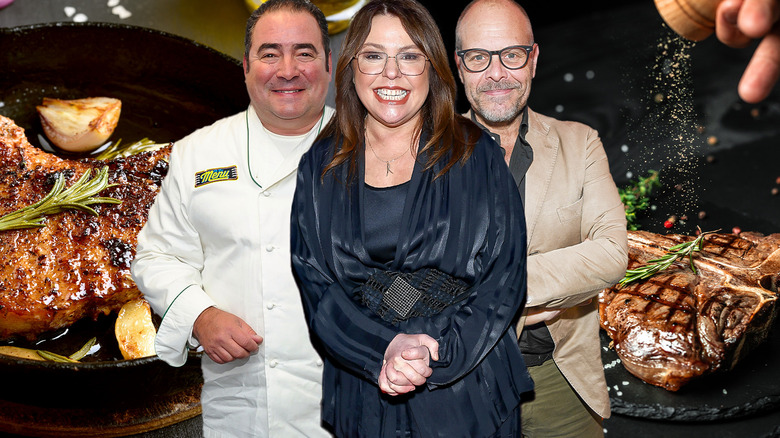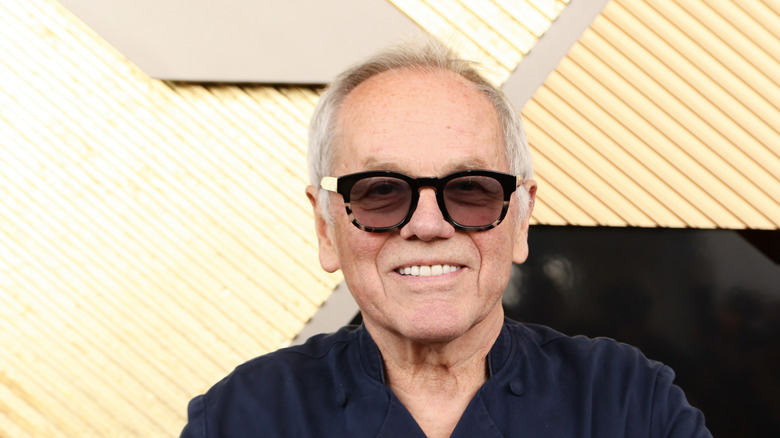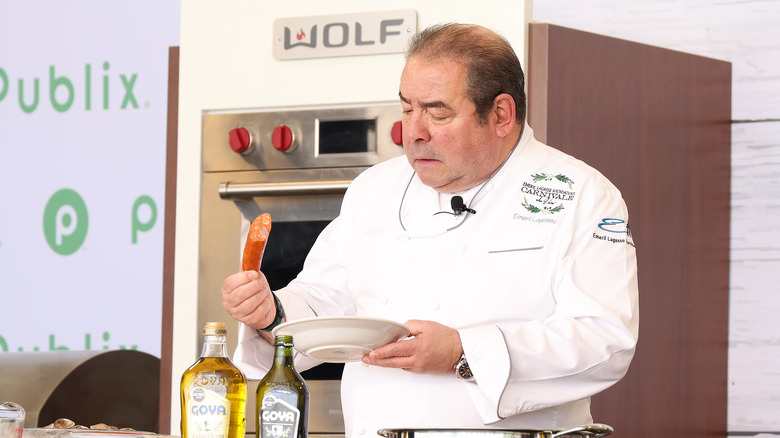13 Tips From Celebrity Chefs For Perfectly Seared Steak
Who doesn't love steak? A prime piece of perfectly cooked red meat is synonymous with luxury. In fact, according to a recent study, almost two-thirds of Americans would choose steak as their final meal. There's nothing like a piece of steak with a browned exterior and a juicy center. It turns out that the reason why steak is so tasty has a scientific explanation, and it has to do with a chemical reaction known as the Maillard reaction, which transforms a piece of raw meat into a complex, charred, umami wonderland of flavor and texture.
And one of the best ways to get the Maillard reaction to work wonders on a piece of steak is by searing it. But how does the Maillard reaction actually work? Amino acids and sugars are both naturally present in red meat and when you add heat, these compounds change shape and react to form new chemicals that have an entirely different flavor profile, one that is much beloved by steak eaters everywhere.
Although the flavor of seared steak is explained by science, people still have very strong opinions about just how to get the perfect sear on your steak. We've gathered some of the best tips and tricks offered by celebrity chefs, so if you're trying to serve a steak that is worthy of the fanfare of some of the most famous chefs around, read on.
Alton Brown uses a cast iron skillet
Since he launched his first show twenty years ago, Alton Brown has become known across the country as one of the most knowledgeable voices when it comes to tips and tricks in the kitchen. His ability to simplify complex scientific principles into neatly distilled and deeply entertaining educational content is unparalleled, which is why we trust him when it comes to the art of searing a steak.
According to Brown, to get that perfect sear, you've got to have the right equipment: a cast iron skillet. A thick cast iron skillet is excellent at retaining heat, so you should put it in the oven before you plan to sear your steak. Once it is piping hot, you can put it on your stovetop and drop your steak into the skillet with a bit of oil. Unlike a regular pan, when the steak hits the skillet, it won't cool down much, ensuring that you'll get a great char with lots of umami flavor. This is no doubt one of the absolute best uses for your cast iron skillet.
Gordon Ramsay brings his steak to room temperature
Gordon Ramsay certainly isn't one to act shy in the kitchen. The Scottish chef and restaurant owner gained celebrity status with a uniquely brash attitude that fans and viewers have grown to love. It's hard not to listen when Ramsay is talking, including when it comes to searing steak.
Ramsay's ultimate tip for searing the perfect steak has to do with preparation. In order to give the steak that yummy crust that is the hallmark of a restaurant-quality sear, Ramsay emphasizes the importance of bringing the steak up to room temperature before it hits the pan. Also, leave the steak outside of the refrigerator for at least ten minutes before you sear it, but it doesn't hurt to leave it out for up to an hour. This allows the steak to cook more evenly and also prevents the meat from becoming tough and dense. Meat in the fridge also has the tendency to absorb the odors around it, and leaving it out before you cook it gives it a chance to rid itself of foreign flavors naturally.
Pat LaFrieda reverse sears his steak
Becoming a butcher isn't typically a path to stardom, but Pat LaFrieda isn't your typical butcher. Starting in the family meatpacking business when he was only ten years old, Pat LaFrieda now sells meat to some of the most renowned restaurants in the country, and his name is synonymous with quality meat. So there's no question why we consider him an authority on all questions of steak.
According to Pat LaFrieda, the secret to a quality seared steak is a process known as reverse searing, which is when a piece of meat is put inside a low-temperature oven until it is brought to the desired internal temperature and then seared on a hot pan to get a crusty, salty, flavorful exterior. One of the delicious benefits to reverse searing a steak is that it loses some of the moisture in the oven, so it doesn't bring down the temperature of the pan, giving you a maximally charred, umami crust.
Bobby Flay isn't shy with seasoning
Bobby Flay has definitely earned his chops in the world of celebrity chefs. Flay opened his first restaurant, Mesa Grill, in Manhattan when he was just 25 years old. Since then, his written several cookbooks and has been a regular fixture on the Food Network for almost twenty years. He also happens to be the owner of Bobby Flay Steak, so it's safe to say he knows his way around a cut of meat.
One of Bobby Flay's best cooking tips for home chefs is not to be shy when it comes to seasoning your steak. Even if you're going for a simple steak, salt it liberally because the salt doesn't just make the meat more flavorful; it helps break down the fibers to make it more tender so that it really melts in your mouth. And don't be afraid to get creative with your seasoning. You can use a whole host of dry spices from your spice drawer to jazz up your seared steak, like paprika, oregano, cumin, and even chili powder, which interact with the heat from the pan to create a seared crust that packs a punch.
Wolfgang Puck starts high and finishes low
Although Wolfgang Puck was born in Austria, he has had a tremendous influence on American cuisine. With an emphasis on fresh ingredients and classic French techniques, Puck changed the way we think about contemporary fine dining. He even earned a Michelin star for his acclaimed restaurant CUT, a steakhouse located in the prestigious Beverly Wilshire Hotel, which is why we wanted to know the method Wolfgang Puck uses to cook steak.
Taking to social media, the celebrity chef revealed in a response video on TikTok that the best way to sear a steak is to get the pan as hot as possible before the steak goes in the pan, and then lower the temperature and finish the steak slowly until it gets to the desired internal temperature. The initial high heat is important for giving the steak a nice crust, and then finishing it on a lower heat gives you greater control of exactly how done you want it. Puck was trained in France, so it's no surprise that he likes his steak rare.
Emeril Lagasse sears the fatty side first
Emeril Lagasse is not known for being shy. The James Beard Award-winning chef has made his mark on the culinary world with his loud personality and breadth of cooking knowledge that he's accrued after working in the food industry for over forty years. It's safe to say Lagasse knows his way around the kitchen, which is why we trust him to know how to sear a steak.
Lagasse insists that you cook your steak on the fat side first when you're searing it, which is especially important when you're searing particularly fatty cuts of beef like ribeye or sirloin. The reason why it's so important is that you want the fat to render in the pan at the beginning of the cooking process so that when you turn the meat over to cook the other side, it gets bathed in the fatty juices that make seared steak such a delicious treat. So next time you're searing steak, remember this tip and BAM! You'll have a perfectly seared steak in no time.
J. Kenji López-Alt salts his steak in advance
Not many chefs can claim to have garnered a following by shooting cooking videos with a GoPro strapped to their heads. But then again, J. Kenji López-Alt is not many chefs. The restauranteur, chef, YouTube star, and editor has taken a scientific approach to when exactly you should season your steak before you sear it.
In a piece written for Serious Eats, López-Alt salted half dozen identical ribeye steaks at ten minutes intervals before searing them. The result? The best results came when the steak was seared a full forty minutes before it hit the pan. The reason is that the salt has a chance to dissolve and then sink into the muscle fibers of the meat, which gives you a piece of meat that is seasoned all the way through as opposed to just salty on the surface. For even better results, says López-Alt, salt the steak on both sides the day before and let it rest on a wire rack in your fridge overnight, and you'll be in crusty seared steak heaven.
Ina Garten uses a marinade
Ina Garten is the queen of a classy affair. From her home in East Hampton, she's captured the attention of any American who wants to turn a simple meal into an elegant dining experience. During her nearly 20-year tenure on the Food Network with her wildly popular show Barefoot Contessa, Garten covered nearly every aspect of domestic kitchen life that there is to cover — and that includes her tips for cooking perfect steaks.
To make your seared steak stand out, Garten recommends using a marinade. A marinade usually consists of an acid, like vinegar or lemon juice, that slightly breaks down the proteins on the surface of the meat, leaving you with a more tender product. When you sear a marinated steak, the marinade also reacts with the heat during the searing process, which can give the exterior of the steak a unique flavor profile depending on the type of marinade that you use.
Derek Wolf scruffs his steak
Derek Wolf loves nothing more than cooking over an open fire. Although he has no formal culinary training, Wolf possesses the personality and know-how that has garnered him millions of followers on Instagram, where he makes videos showing viewers how to cook over an open fire. And Wolf is certainly a meat lover, which is why we've decided to include him in this list.
When you sear a steak, you're really looking for that delicious char that forms on the exterior of the meat when it hits a hot pan. Derek Wolf's method to maximize the crust on steak starts with a method called scruffing, which is when you score the steak on both sides with a knife. This gives the meat more surface area to be in direct contact with the pan, which results in a great portion of the meat that receives the distinct outer char that makes a seared steak great.
Lidia Bastianich brushes her steak with olive oil
Chef and restauranteur Lidia Bastianich is no stranger to olive oil. The poster child for Italian-American cuisine, many of Bastianich's recipes, like her signature lasagna and baked ziti, involve olive oil, which forms the mighty backbone of Italian cooking. She also uses it to sear the perfect steak.
Before your steak hits that hot pan, brush it with a bit of olive oil. Extra Olive oil has a low smoke point, which means it won't burn easily when it makes contact with heat during the searing process. But be sure to use light olive oil as opposed to extra virgin, which has a lower smoke point and can end up burning in the pan. Light olive oil also has a light flavor profile that accentuates the taste of the crust that forms on a seared steak. It also prevents the meat from sticking to the pan so that you don't have trouble taking it out when it's done cooking.
Jet Tila Pats his steak dry before searing
Jet Tila is a Los Angeles legend. His parents were immigrants, and Tila was raised in the restaurant industry just when Thai food was gaining popularity in mainstream American culinary culture. He supplemented his knowledge of Asian cooking with a degree from Le Cordon Bleu, so it's safe to say Tila has a wide breadth of expertise to draw on when it comes to cooking.
When it comes to searing steak, Tila has a method that maximizes the crust on the steak's exterior. Before you season your meat, and long before you put it in the pan, you should pat your steak dry with a paper towel to remove all of the residual moisture from its surface. As we know, high heat is crucial for the Maillard reaction to take place, which gives us the umami crust we're always chasing after when we sear steak. If the surface of your steak has a lot of moisture on it, the heat energy from the pan heats up the water instead of heating up the meat itself, so the steak doesn't have a chance to get quite as nice and crusty.
Heston Blumenthal flips his steaks every 10-15 seconds
Searing steak can sometimes be a controversial affair. Different opinions abound on just how to maximize the flavor potential of a piece of red meat. Heston Blumenthal, the restauranteur behind the three Michelin star Fat Duck in the United Kingdom, thinks he has the answer. And with credentials like that, we're going to pay attention.
According to Blumenthal, you've got to helicopter parent your steak when you're searing it. Stay by the pan because he recommends you flip your steak every 10-15 seconds throughout the cooking process. Not only does will your steak be done more quickly, this process also minimizes the grey band of meat that is usually between the pink center and the charred exterior of the meat, leaving you with the most flavorful parts of a seared steak. While you might think this method would leave you with less brown crust because the exterior of the meat has less contact with the pan, it actually helps develop a charred exterior by letting the moisture evaporate with each flip, allowing the dry meat to have more contact with the pan and enhancing that Maillard reaction.
Giada de Laurentiis waits to flip her steak
Giada de Laurentiis is so much more than just her winning smile. The celebrity chef has brought Italian cooking to the masses in the United States with several cookbooks and shows on the Food Network that have reached millions of home chefs. In her repertoire, de Laurentiis has a recipe for just about everything, so it doesn't come as a surprise that she has opinions when it comes to searing steak.
Giada de Laurentiis' trick for making steak in a cast iron skillet relies on one very important factor: patience. Her simple method involves just a steak, seasoning, olive oil, and a hot cast iron skillet. After you place the meat in the skillet, the trick is to sit back and do nothing. For three to five minutes, that is, or until the steak has enough time to develop that characteristic char that makes seared steak one of our favorite things to eat. While many chefs believe you should flip the steak several times, Giada stands by her method. "Do not move it around, do not flip it early," she says in a video on Instagram. As the saying goes, patience is a virtue.













